Berkeleyan
Say hello to 2003-04’s new faculty
![]()
10 March 2004
Each spring, for many years, the Berkeleyan produced a special insert highlighting the dozens of new faculty members who arrive on campus each year. But this year the office of the Vice Chancellor for Research has developed a comprehensive website featuring profiles and photos of the year’s academic newcomers.
Now that even spring-semester starters have arrived on campus, we are pleased to highlight the new website and offer profiles of just five of this year’s crop of 87 new faculty, whose credentials in disciplines from business to zoology lend further luster to Berkeley’s tradition of academic excellence.
Associate Vice Chancellor Robert Price directed the development of the faculty site, as well as his office’s recently launched site on Berkeley research. He says, “One reason we created the new research website is to present to the campus and the public an easily accessible window on the breadth and depth of the extraordinary research being done at Berkeley. Each year we expand on that by the addition of dozens of new faculty members to our campus community. It seemed fitting that we make public the incredible range of scholarly interests that have been added to our university by introducing the new members of our faculty.”
We hope the profiles on this page will entice you to read more about all of Berkeley’s new faculty for this year. To view the entire roster, visit research.chance.berkeley.edu and scroll down to the “Meet Berkeley’s New Faculty” link on the right-hand side of the page.
—The Editors
Julia F. Hastings
Assistant Professor of Social Welfare
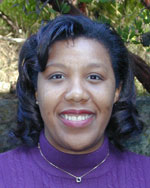 Julia Hastings |
“ To pay attention to diversity does not simply mean you say, ‘I have people of color in my research study,’” explains Julia Hastings. “Researchers need to start by thinking about how they design their research questions.”
Hastings’ research interests include poverty and mental health among ethnic minority populations, the relationship between mental health and welfare participation, and health issues facing ethnic minority women. While studying the relationship between poverty and mental health, she became intrigued by an “epidemiologic paradox” whereby African Americans record lower rates of depression than whites, but report a higher number of depressive symptoms. African Americans, says Hastings, defy the social-stress theory — which holds that higher stress leads to worse mental health. This conundrum raises questions about how to consider the role of race and culture in detecting mental disorder. Understanding the cultural meaning of depression symptoms for African Americans is yet another research area for Hastings, who believes study in this area will be more important as society becomes more culturally diverse.
Her teaching position at Berkeley is her first. “My learning curve as a new teacher,” admits Hastings, “has been steep.” Her students, too, she says, have been challenged, “because I stress the importance of culture and diversity in every aspect of the research process.” She teaches Social Welfare Research, a year-long course intended to help future social workers evaluate the effectiveness of their practice in social service agencies.
“My students tell me they are learning the business of ‘doing,’ and I counter, they are really in the business of ‘doing better.’ I want them to understand that social workers use research every day to improve service delivery and it is imperative that the services offered are culturally appropriate and sensitive.”
A native of Stockton, Hastings says “returning to California after I finished my doctoral work was my dream.” She earned an M.S.W. from the University of Washington and then received her Ph.D. in Social Welfare from UCLA. Her postdoctoral work took her to the University of Michigan at Ann Arbor, where she will return this summer to complete the requirements for a Certificate in Epidemiology.
Hastings also completed her undergraduate work at UCLA, a complicating factor as a season-ticket holder for Cal Bears football. When asked who she roots for during Bears -Bruins match-ups, she smiled and responded, “The winning team! If there is a tie, I am blessed.”
—Wendy Edelstein
Kristen Whissel
Assistant Professor of Film Studies
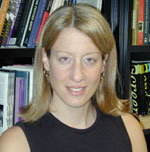 Kristen Whissel |
The early films that Kristen Whissel scrutinizes are less than a minute long. Screened as part of the entertainment in vaudeville theaters, early non-fiction films helped American audiences “make sense of the political, economic, and social changes that technology was bringing to everyday life,” Whissel says.
“Cinema helped articulate recent history,” says Whissel, “and made the changes industrialization brought about visible, meaningful, and pleasurable for audiences.” In the late 1800s, magazines rarely used photographs — engravings were a more typical means of illustration — so film, in addition to its novelty value, offered the public a singular lens on events.
Whissel uses early short non-fiction films made by the Edison Manufacturing Company to study various chapters in turn-of-the-century American history. In a just-completed manuscript, Picturing
American Modernity: Traffic, Technology and the Early Cinema, she details examples of how early cinema represented both the possibilities and limitations of new technology.
In the opening chapter, she examines the “fetishization” of soldiers and
battleships in early films as the U.S. military prepared for the Spanish-American
War. Films of that period, which placed the U.S. at the apex of “modern
civilization,” were, she says, far more complex than everyday jingoistic
propaganda. When spectacles of technological breakdown (such as the destruction
of the U.S.S. Maine in Havana harbor) revealed modernity’s perils,
says Whissel, subsequent films quickly expressed the idea that industrial
progress would nevertheless forge ahead.
“Once the war began, the impact the films’ images had on public perceptions was important,” says Whissel. “They helped promote the war as an opportunity for the growth and expansion of U.S. power.” Much was made, she says, of the idea that in the process of securing new markets for American industry, the U.S. would also “rescue” Cubans and Filipinos from oppressive rulers. “That really echoes what is happening in Iraq today,” observes Whissel.
The Buffalo, N.Y., native earned her Ph.D. in English from Brown University and taught previously at the University of Glasgow and the University of Michigan.
Whissel is thrilled to be in the Bay Area: “Save for New York, in terms of film culture, I can’t imagine a better place to be.”
— Wendy Edelstein
Peter Bartlett
Professor of Statistics
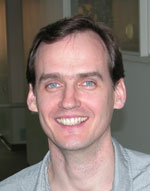 Peter Bartlett |
When talking with Peter Bartlett about the complexities of machine learning, there is no need to venture into the realm of science fiction. While movies such as 2001: A Space Odyssey and AI have brought the notion of artificial intelligence to the mainstream public, researchers today are focused on practical tasks — reliably recognizing text in a document or people in a photo — rather than getting machines to act like humans.
“In this area, we’re not trying to build another brain,” said Bartlett, who joined Berkeley’s full-time faculty as a professor of computer science and statistics in 2003. “We’re developing programs that can accomplish a job.”
Bartlett’s research focuses on developing statistical models to help computers make decisions in conditions of uncertainty, such as recognizing words in optical-character-recognition problems, or understanding what a sentence means. Moreover, he is studying ways to automate the process of learning from mistakes and adjusting future choices accordingly.
“We are developing algorithms that use data — examples of the right choices to make — so that the probability of the computer making the wrong choices in the future continually decreases,” says Bartlett. “The whole game is automating that so that the learning takes place quickly.”
A native of Australia, Bartlett came to Berkeley as a Miller visiting professor in 2001 with a strong background in machine learning. He co-authored a book on neural networks, and has served as associate editor and board member of numerous journals in his field. In 2001, he was awarded the Malcolm McIntosh Prize for Physical Scentist of the Year, one of the most prestigious honors awarded by the Australian government to a scientist under 35.
“The field of artificial intelligence has matured so that people are no longer satisfied with cute tricks,” said Bartlett. “Our goals now are to design and analyze systems that can successfully solve specific problems.”
— Sarah Yang
Robert Dudley
Professor of Integrative Biology
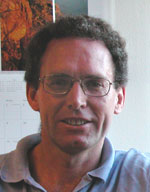 Robert Dudley |
One advantage of studying hummingbirds, at least for Robert Dudley, is that the research subjects fly right in through the window. His students periodically net hummingbirds as they visit feeders mounted just inside the windows of his lab in the Valley Life Sciences Building, provide them with room and board for a couple of days, put them through their paces in a 26-foot wind tunnel, and then release them. (All done with the requisite federal, state, and campus permits, of course.) The holiday must be to their liking, because the same birds return time and again.
The goal of these studies is to uncover the secrets of hummingbird flight, says Dudley, who arrived a year ago from the University of Texas, Austin, where he taught for 10 years. Hummingbirds are the only bird that can hover indefinitely, which makes them more like insects than birds. Dudley marks their wings and films their wind-tunnel flight with high-speed video cameras to see how they fly, dart, hover, and maneuver under various conditions. He’s also stalked them in the wild, as in his recent census of hummingbirds in the Andes of Peru to determine how they handle differing oxygen levels and air density at varying altitudes.
In his desire to understand the mechanics and evolution of flight, he has tracked orchid bees in Panama, bats and butterflies in Central America, flying squirrels in the lab, and now bumblebees in the foothills of the Tibetan Plateau. He’s even put a student to work on a human-centered project: studying how a Chinese carrying stick called a bian dan makes carrying balanced loads easier. (“It all has to do with biomechanics,” he said.)
Dudley’s curiosity does occasionally lead him astray, however. He’s currently delving into the question of why animals from fruit flies to humans are attracted to alcohol. Precious little data exist on animals’ consumption or tolerance of alcohol, obtained primarily from fermenting fruit, though anecdotes abound about inebriated elephants, monkeys, and birds. He is sending a student to Panama next summer to measure the ethanol content of ripe fruit, and hopes to repeat this in Uganda next year.
Says Dudley of Berkeley, “I love it here. Not just my department, but the overall strength of the institution. Every department here is strong.”
— Robert Sanders
Saba Mahmood
Assistant Professor of Anthropology
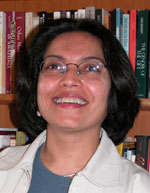 Saba Mahmood |
When the first Gulf War broke out, Saba Mahmood, then an architect practicing in the United States, decided to go back to school to study the Middle East, an area “much more complex than we could imagine,” as she saw it. Events since have confirmed her hunch and placed issues addressed by Mahmood’s research squarely in the forefront of current affairs.
An anthropologist with a doctorate from Stanford University, Mahmood, who was born in Pakistan, spent two years in Egypt studying the thriving movement of Muslim women who meet together in mosques to read Islamic scriptures without the mediation of male religious authorities, and to discuss how to apply the teachings to their lives.
What’s perplexing for many observers of this mosque-based “piety” movement is that it’s not an instance of women attempting to free themselves from male oppression — a plot line that fits well with standard feminist formulations. Instead, the women Mahmood observed and interviewed are reaffirming traditional interpretations of the Q’uran— for example, abiding by protocols of strict sex segregation — though applying it to unprecedented, modern situations such as working in mixed-sex offices and using public transportation in close proximity to men.
In her forthcoming book — The Politics of Piety: The Islamic Revival and the Feminist Subject — Mahmood uses her research in Egypt to raise several provocative questions. One is whether, in the light of such movements, it’s accurate to assume that securing one’s freedom and autonomy is, a priori, a primary motivation in human action, as the ideology of freedom — now embraced by people throughout the world — proposes. She also explores the political implications of the mosque movement: As women, based on the teachings, make decisions about what schools to send their children to, where to invest money, and how to behave in public spaces, does their impact on social relations eventually affect configurations of political power as well?
Mahmood is currently teaching a graduate anthropology seminar on the relationship between liberalism and secularism. She hopes next to compare secularism in postcolonial Syria, Egypt, and Pakistan. As Western and non-Western societies alike grapple with issues related to religion and politics (think of government decrees, both in France and Turkey, against the wearing of Muslim head scarves), she hopes to explore the assumptions behind a secularist world view and “the wide variety of sensibilities condensed within the term.”
— Cathy Cockrell

